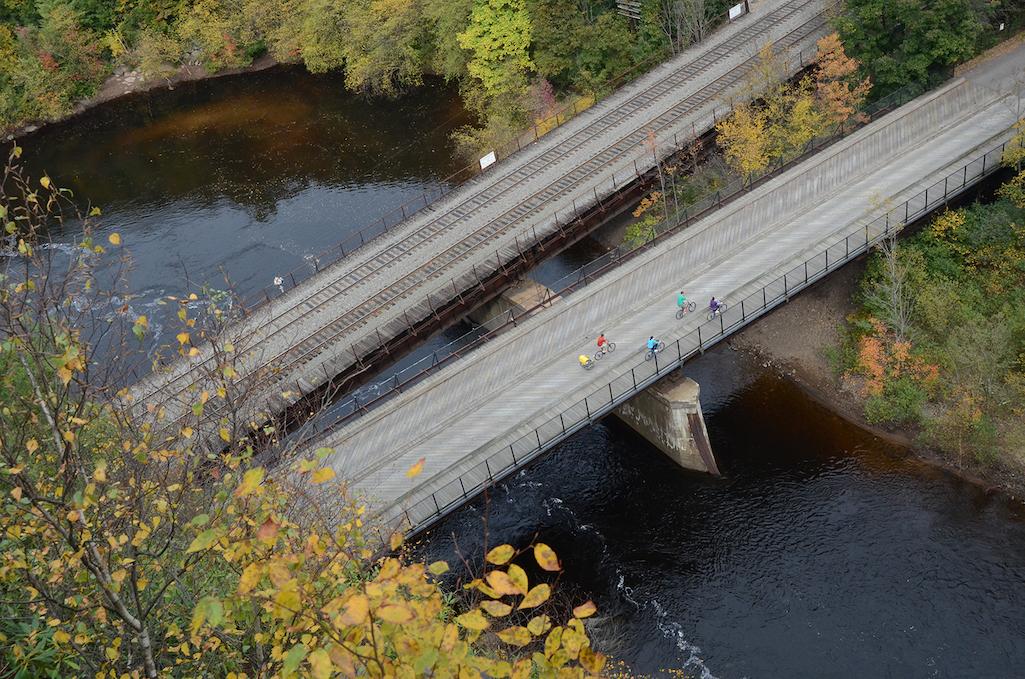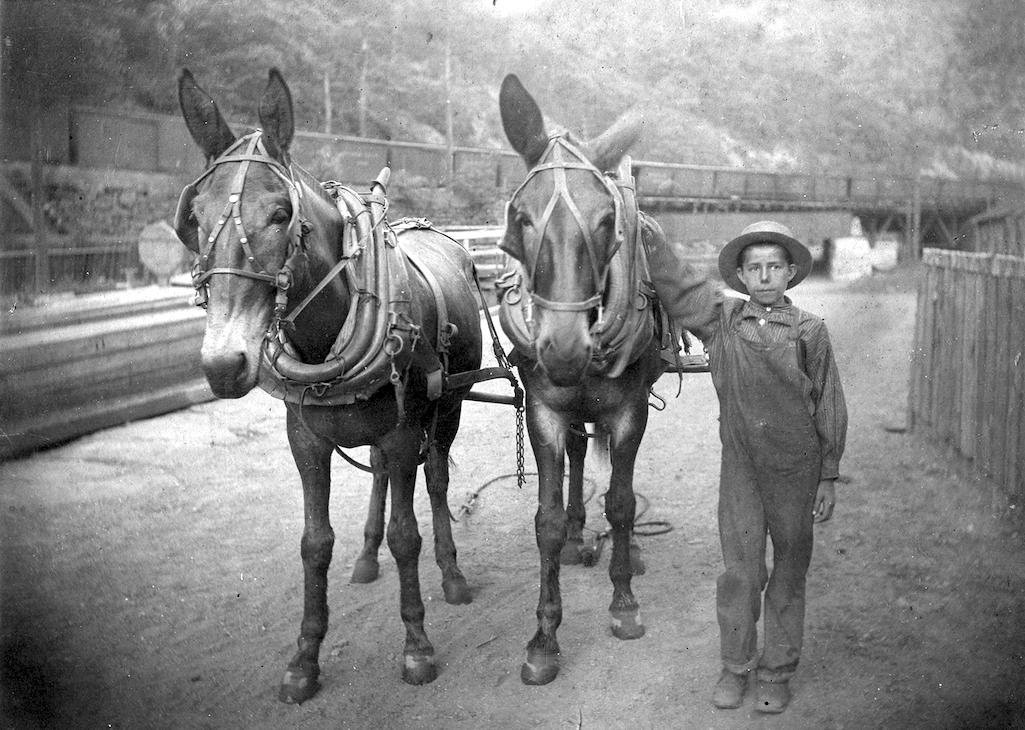
The railway bed next to the Delaware and Lehigh Trail is the bridge to Glen Onoko Falls Trail near the town of Jim Thorpe/Delaware and Lehigh National Heritage Corridor
Walking The Lehigh Valley
By Phil Lupsiewcz
Editor's note: National Heritage Areas are places where historic, cultural, and natural resources combine to form cohesive, nationally important landscapes. Unlike national parks, National Heritage Areas are large lived-in landscapes. Consequently, National Heritage Areas entities collaborate with communities to determine how to make heritage relevant to local interests and needs. This article focuses on the Delaware and Lehigh National Heritage Corridor, one of 55 national heritage areas across the country that fall under the oversight of the National Park Service.
It wasn’t what we had planned to do. Nope. Our original idea was to do a couple “volkswalks” in eastern Pennsylvania. Jim Thorpe and Bethlehem to be exact. I, as the trip planner, had not expected to be going to the Delaware and Lehigh National Heritage Corridor, but when we arrived In the Lehigh Valley, its presence was there and in order to understand the history of the area we found many opportunities to be out along the towpath and wishing we had a canoe or kayak to travel on the Lehigh River.
Jim Thorpe and Bethlehem are two communities steeped in industrial history. Jim Thorpe, originally call Mauch Chunk, was renamed to honor the Sauk and Fox nation member and athlete Jim Thorpe, considered the greatest athlete of the first half of the 20th century. Our plan was to walk the town, which contains a unique series of buildings dating from the mid-19th century. It’s a community that has embraced its iron and transportation heritage through several magnificent historic sites, the Lehigh River, Lehigh Gorge State Park, and the Delaware and Lehigh Coal and Navigation Canal, now called the Delaware and Lehigh National Heritage Corridor.
We spent the morning walking Jim Thorpe. We admired the mid-19th century buildings holding shops, speciality food stores, restaurants, and even the Mauch Chunk 5 & 10. We decided to walk to the Glen Onoko, a waterfall area located just over two miles from town in the southern section of the park. The walk was pleasant and wide enough for walkers and bicyclists to share the towpath/trail.
The park refers to the trail as the Lehigh Gorge Trail, a multi-use trail that so happens to be the Delaware and Lehigh towpath trail. The walk was lined with waysides that told the story of the area. However, we did find many of the waysides difficult to read due to fading. Happily, a link to the website did provide current information on trail conditions, "likes" to community sites to visit, as well as services offered and businesses that support the mission of the heritage area.
Later, we drove up to another waterfall in the park, Buttermilk Falls, located approximately a quarter-mile from the trailhead in Rockport, Pennsylvania. The walk was very comfortable as it was later in the day and the sun was no longer overhead. On our visit, it was a real joy to visit the waterfalls and enjoy its cooling spray on this hot, humid day. Back at the lot, we watched several groups of people prepare their inflatable boats as they were getting ready to enter the Lehigh River. We even noticed several older people set up chairs and watched the paddlers embark. This was clearly a spot of many activities, from boaters to cyclists and hikers and just people relaxing and people-watching.
Our next day brought us to Bethlehem, home of Bethlehem Steel, Lehigh University, and Moravian College. We began our sanctioned 10-kilometer volkswalk from the Hotel Bethlehem. Walking just past the hotel, we encountered an old town of sorts that held the original industrial center of the Moravian settlement. This is a national historic landmark district that includes numerous buildings associated with Bethlehem’s settlement and early prosperity. Just steps away, and part of our volkswalk, was the Delaware & Lehigh Canal.

Daniel McCollick of Erwinna with his team at Mauch Chunk in 1911/Delaware and Lehigh National Heritage Corridor
Several years ago, my life partner and I discovered the joys of “volkswalking.” Walks designed to take you either 5 kilometers or 10 kilometers in urban/ suburban settings. Unlike a trail in a park, you need to register at an approved location, pick up a walk map and a registration card. Most walks have a checkpoint or two, where you answer a question posed to you on your registration card. After your walk, you either return the card to the “walk box” where you began your walk, or send it to the local person who serves as the walk coordinator.
To receive “credit” for your walk, you record your walk with a passport and ink stamp that designates the walk taken. In addition, a small administrative fee is charged for your walk. We have found $3 per person the usual fee we select for our walk and credit. You can do the walk for free, but you do not receive official credit from the American Volkswalk Association, the national organization that administers walks thorough state and regional clubs.
After so many events (walks), or kilometers, you can send your passport in for official validation and receive a pin to commemorate your accomplishment. Many volkswalks are now available on-line, allowing you to search, register and confirm your participation, but we still enjoy getting our passports stamped by our own hand.
Our walk on the towpath provided us with a stark contrast to the Lehigh Gorge we walked the day before. Now we were in an urban area, which in some ways was left alone while the city of Bethlehem grew up around it. Today one can walk the towpath and be under a canopy of trees with open vistas to the south of Bethlehem and the remainder of the mammoth Bethlehem Steel plant.
Now in redevelopment the company, which employed more 300,000 people at the height of its sprawling operations, seems to sit idly by, but it’s not. The complex has been under redevelopment for some time and several of the furnace stacks still stand as a reminder of the the past. Equally, those same stacks function as a cultural attraction as well as an area of economic redevelopment that includes a hotel and casino and an art museum called “The Banana Factory.” The National Museum of Industrial History, an excellent museum with a 120-acre complex providing the story of America’s industrial development and the people and machinery that made it happen.
Our visit to the Lehigh Valley illustrated the the success of National Heritage Areas, as the Delaware & Lehigh clearly provided numerous connections to the region as a whole. Our visit was mainly focused on the cultural history of the area, but the opportunities to incorporate the natural world in our visit made our understanding of the region more complete. To see towns and cities embrace their past and utilize their inventory of natural and cultural resources gives us all the opportunity to experience an authentic visit in a world we many never consider.
For more information:
Delaware and Lehigh Navigation National Heritage Corridor
delawareandlehigh.org
American Volkssport Association Ava.org
Phil Lupsiewcz, recently retired from the National Park Service, was a public information officer at Lowell National Historical Park and nearby Minute Man National Historical Park.



Comments
Thank you Phil for a very enjoyable article. Years ago, Jim Thorpe used to be one of my stomping grounds--and where I learned a good deal of American history, some of which I lived during the declining years of the anthracite coal mining industry in Pennsylvania. Not to be outdone in attracting tourists, the Lehigh Valley Railroad dubbed Jim Thorpe and environs the "Switzerland of America," and did bring thousands of people every summer to Pennsylvania's mountain resorts. Fortunately, Rowman & Littlefield is slowly republishing the Rivers of America series, including, just released, The Susquehanna by Carl Carmer. Folks interested in the history of this region may want to pick it up. I was honored to be asked to write the foreword.
https://www.amazon.com/Rivers-America-Susquehanna-Carl-Carmer-ebook/dp/B...